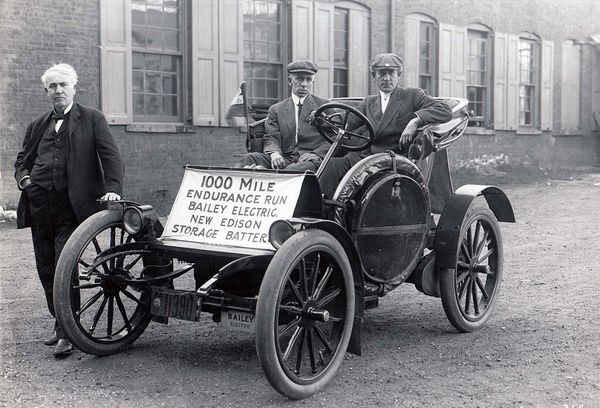
Photograph courtesy Thomas Edison NHP, NPS/DOI.
To inventor Thomas Edison in the early 1900s, electric cars looked like the future of transportation.
Although better known for inventions such as the light bulb and motion pictures, Edison also designed three electric cars using his nickel-iron Edison Storage Batteries. Here he is seen standing beside a model that left New York on a 1,000-mile promotional “ideal tour” in September 1910, charging along the way and ending with an ascent up New Hampshire’s Mount Washington.
By the time Edison’s battery (a longer-lasting, lighter-weight improvement over previous lead-acid batteries) was ready for this journey, electric cars had already been on the road for more than 15 years. In 1899 and 1900, more electric cars were sold in the United States than any other type of vehicle. In 1903, London boasted more electric cars than vehicles with internal combustion engines.
“The problem so far has been to build a storage battery of light weight which would operate for long distances without recharging.”
The first EV heyday was brief, however, and Edison’s battery came along as Ford’s more affordable Model T was gaining prominence. Even so, Edison and Henry Ford himself planned to develop a low-cost electric car as late as 1914. In January of that year, Ford told reporters in New York, “The problem so far has been to build a storage battery of light weight which would operate for long distances without recharging.” The pair envisioned a 1,100-pound car containing 405 pounds of battery equipment, priced at $600, Ford said. “How does that compare with the great, heavy, and expensive electric cars?”
The basic design of an electric vehicle propulsion system, with its rechargeable battery pack powering an electric motor, offers efficiency advantages over the internal combustion engine. According to the U.S. Department of Energy, electric motors can convert 75 percent of chemical energy from the batteries to power forward motion (some energy is lost as heat), while internal combustion engines put only 20 percent of the energy in gasoline toward moving the vehicle. Tesla Motors, maker of the electric Tesla Roadster and upcoming Model S electric sedan, claims its Roadster has 88 percent drive efficiency.
The Ford-Edison project ultimately fell through, partly due to battery troubles. And according to a history of the electric car published by the Institution of Electrical Engineers and the Society of Automotive Engineers, the final new American electric car built during Edison’s era was a 1921 model, the Automatic, capable of traveling 25 miles per hour and 60 miles on a charge. The Automatic sold for $1,200—more than four times the price of a Model T at that time.
Reposted from Wired.
